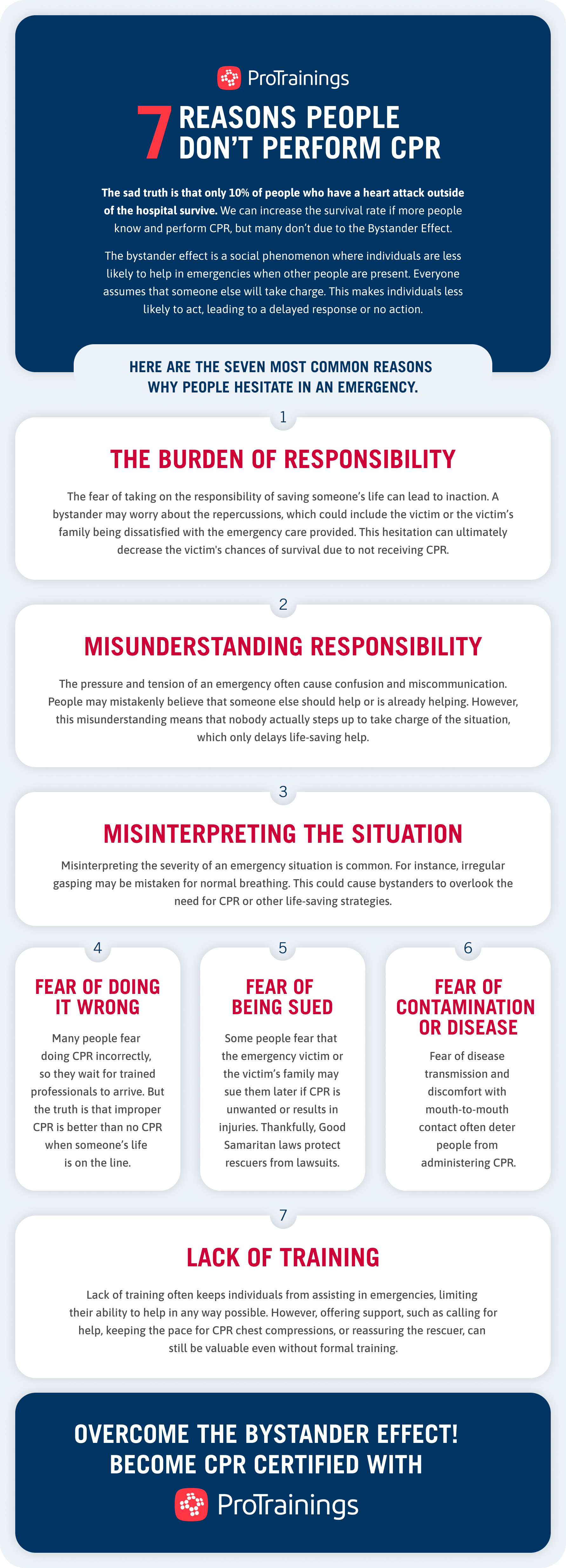Table of Contents
- The Bystander Effect
- 7 Reasons People Don’t Attempt CPR
- How to Overcome the Bystander Effect
- Every Second Counts
Most of us hope that when we experience an emergency, someone will come to our rescue. But the reality is that far too many people hesitate to give life-saving aid. Often, this is because they believe someone else will — or should — do it instead. This phenomenon is commonly known as the bystander effect.
According to a study in the Journal of the Chinese Medicine Association, of 142,740 people who experienced cardiac arrest, only 32% received CPR from a bystander despite 53% of these emergency events being observed by onlookers. There are many reasons people may hesitate to administer CPR to a stranger, but most can be overcome with training and a better understanding of what’s needed in an emergency.
Whether you hesitate to perform CPR out of fear, uncertainty, or feeling unqualified, you’re not alone. But those fears and misconceptions don’t have to stop you from saving a life. Understanding what keeps you from helping someone in need is the first step to gaining the confidence and skills you need to take action.
Read on to learn more about the bystander effect and how to overcome common fears and misconceptions that prevent people from administering CPR in an emergency.
The Bystander Effect
Also known as bystander apathy, the bystander effect is a theory first introduced by John Darley and Bibb Latané that states that the presence of other bystanders in an emergency decreases the likelihood that someone will help.
Following the murder of Kitty Genovese, who received no help despite the presence of multiple witnesses, Darley and Latané conducted a series of experiments that helped them both define the bystander effect and begin to understand why people hesitate to intervene when an emergency occurs.
While the reasons for a bystander’s inaction can and do vary, Darley and Latané found that often people simply assume that someone else will help, so they don’t need to. But when everyone makes this assumption, no one steps forward, and the emergency victim may not receive the help they need until after it’s too late.
The Fight, Flight, Freeze Response
A natural response rooted in our evolutionary past can lead to the manifestation of the bystander effect — fight, flight, or freeze. Humans developed this response when environmental awareness and responses to threats were crucial for survival.
In stressful or emergency situations, some people may jump up to help. This is called the fight response. Many brave first responders possess this quality. It could involve administering CPR, providing first aid, or immediately calling for help. They don’t back down from the situation and take a proactive, empathetic approach.
Fight, flight, or freeze is our body’s instinctive reaction to stress.
Others may experience the urge to flee from the situation, also known as the flight response. This response is often driven by fear, uncertainty, or feeling like they’re unable to handle the emergency. Live-saving skills training to gain confidence can be extremely beneficial for these individuals.

Lastly, individuals could also become immobilized or uncertain about what action to take. This is a freeze response, stemming from shock, indecision, and feeling overwhelmed by the situation. Despite recognizing the need for action, those experiencing this response find themselves unable to act due to conflicting impulses and emotions.
These responses are influenced by factors such as personal characteristics, past experiences, and the perceived level of danger in the situation. Whether it be fight, flight, or freeze, each response serves as a natural protective mechanism for personal safety and well-being.
Emergency Versus Non-Emergency Situations
Another way the bystander effect arises is when it’s time to decide whether a situation is an emergency.
In emergency situations, people may feel uncertain about the situation or fear making a mistake in front of others. They may also look to others for cues on how to behave, and if nobody else is taking action, they may interpret this as a signal that no action is necessary.
Signs of an emergency include situations where someone’s life or safety is in danger and when immediate professional help or action is required.
On the flip side of emergency situations, with non-emergencies, there’s no immediate threat to anyone’s well-being, no pressing need for professional assistance, and no urgency to prevent harm.
In non-emergency situations, like witnessing someone being harassed or where a minor injury takes place, individuals may be less likely to intervene if others are present. They assume someone else will step in, or they worry about what others might think if they act alone.
Sometimes, you may have a hard time deciding whether a situation is an emergency. For example, when people fall, injuries to the head, neck, and back are common, and it can be tricky to determine if they need urgent help. Watch our video to learn more about assessing head, neck, and back injuries:
If you see an emergency happening, don’t wait for someone else to help, because everyone else may be waiting for you to act first. Instead, do what you can to help as soon as you recognize that there is an emergency. Even better, start preparing now by getting CPR certified so you’ll be well-equipped to administer life-saving aid.
7 Reasons People Don’t Attempt CPR
The bystander effect can occur for many other reasons. Sometimes, people hesitate to help in an emergency due to their fear response. Other times, misconceptions prevent them from knowing what to do or from recognizing that an emergency is happening.
It’s important to understand the factors that could stop you from administering life-saving aid so you can overcome them when the need arises.
Here are several other factors that may contribute to the bystander effect by causing people to hesitate instead of performing CPR:
The Burden of Responsibility
One possible contributor to the bystander effect is the fear of taking on the burden of responsibility for saving a person’s life. There’s no guarantee that the victim will survive, so it may feel easier to let someone else take responsibility in case the victim dies.
On the other hand, even if the victim does survive, some people may hesitate to take responsibility for making decisions on their behalf. They may worry that the victim or the victim’s family will be dissatisfied with the emergency care provided, especially if any mistakes are made in the process.
The problem, of course, is that if everyone hesitates to take responsibility, no one will take action, and the victim is even less likely to survive.
Don’t let the fear of being responsible for someone’s life hold you back from administering emergency aid. Instead, offer help to the best of your abilities. Even if you fail to save them, at least you’ll know you did as much as you could.
Misunderstanding Responsibility
In an emergency, tensions are high. Many people find it difficult to act quickly and calmly under such pressure, and miscommunication can easily happen. Sometimes, the bystander effect can occur not because people hope someone else will help, but because they misunderstand the situation and believe someone else should help or is already helping.
In such a case, it’s important for someone to step forward and take charge of the situation. This person can instruct other bystanders to call emergency services, help secure the environment, and administer aid. That way, there’s no confusion about who should do what. And remember: that person can — and often must — be you.
The best way to ensure you understand your responsibility in an emergency is to be trained and certified in CPR. Then you’ll know exactly what needs to be done when you encounter a situation that requires CPR, and you’ll be able to delegate responsibility to other bystanders as needed.
Misinterpreting the Situation
Not every emergency looks life-threatening. Sometimes, a person in need of life-saving aid may appear to be fine, especially to untrained lay rescuers. In this instance, the bystander effect results in people failing to understand that they need to help instead of ignoring an obvious emergency.
For example, agonal breathing — an irregular gasping for breath — is usually caused by cardiac arrest or some other medical emergency. However, lay rescuers may mistakenly assume that because the person appears to be breathing, they don’t need CPR.
In such a case, it’s important to call emergency services immediately and describe the person’s irregular breathing, then perform hands-only CPR until medical professionals arrive on the scene.
Of course, this is not the only example of ways a bystander might misinterpret an emergency situation. Other examples include:
- Failing to recognize other signs that CPR is needed
- Assuming someone else has witnessed the emergency and is providing aid
- Believing that, as a bystander, they aren’t qualified to help
Recognizing and responding quickly to an emergency can mean the difference between the person living or dying. By getting trained and certified in CPR, you can prepare yourself to spot an emergency early and offer immediate aid.
Fear of Doing It Wrong
For untrained bystanders, the thought of attempting CPR can be daunting. Many people fear that if they perform CPR incorrectly, they will hurt the person they are trying to save. They don’t want to make a bad situation even worse and believe the best thing to do is to wait for trained professionals to arrive.
In such a case, the bystander effect stems from good intentions of not wanting to harm the person. After all, they’re already in a vulnerable state, and most people don’t want to add more pain on top of what the person is already experiencing.
The truth is that doing something is always better than doing nothing.
Even if performing CPR does cause injuries, such as broken ribs, to the person in need, that’s still better than letting them die because rescue personnel arrived too late.
Fear of Being Sued
Alongside the fear of performing CPR incorrectly and causing further harm, many people fear that the emergency victim or the victim’s family may sue them later for administering unwanted aid. Like the bystander effect and the fear of taking responsibility, this fear can cause people to hesitate and leave the rescuing to someone else.
However, while it is possible for someone to attempt to sue you for saving their life, it’s extremely unlikely they will succeed. Most lay rescuers are protected by local Good Samaritan laws, as long as they act in good faith and without gross negligence.
While there are a few instances in which you should not attempt CPR, as a general rule it’s essential to act as quickly as you can without endangering yourself or the victim. You can worry about potential (but unlikely) legal consequences after you save the person’s life.
Fear of Contamination or Disease
Another fear that prevents people from administering CPR, especially rescue breathing, is the fear of catching any disease or illness the victim may be carrying. Additionally, many people find the idea of touching a stranger’s lips with their own to be uncomfortable, even if illness is not a concern.
While you should never put yourself in a dangerous situation while trying to save someone else, in most cases it’s entirely possible to perform CPR on a stranger without putting your health at risk.
If you’re uncomfortable giving rescue breaths, you can still perform hands-only CPR until medical professionals arrive. You can also use rescue breathing masks or barriers as a layer of protection between your mouth and the victim’s.
Being trained to perform CPR — with or without rescue breathing — will help increase your confidence in saving lives without endangering yourself in the process.
Want to learn more about other common CPR bystander fears to proactively overcome them? Check out this video:
Lack of Training
Sometimes the bystander effect occurs when someone witnesses an emergency but believes they aren’t qualified to help, usually because they aren’t a trained medical professional. This belief often goes hand in hand with the fear of performing CPR incorrectly.
Of course, the best solution is to get trained and certified in CPR. This will not only eliminate the belief that you aren’t qualified to help but also give you greater confidence that you can perform CPR safely and effectively.
However, even if you aren’t yet certified in CPR, that doesn’t necessarily mean you aren’t qualified to save a life. Other ways you can provide support in emergency situations include:
- Calling for help
- Providing comfort and reassurance to victims and other bystanders
- Controlling the scene
- Acting as a witness to relay information to emergency services when they arrive, or for related police or insurance reports
The important thing is to help the emergency victim to the best of your abilities until trained professionals arrive on the scene.
Prefer a visual of the seven reasons people don’t perform CPR? We’ve got you covered!

How to Overcome the Bystander Effect
Now that you understand common causes of the bystander effect, how can you overcome these fears and misconceptions and offer emergency aid with confidence? Here are a few actions you can take:
- Be alert: An emergency can happen anywhere, at any time, to any person. You don’t have to go about your daily life constantly on edge and expecting bad things to happen, but you can stay aware of what’s going on around you. Then when you see an emergency occur, don’t hesitate to act.
- Have a plan: Many people don’t know how they will respond to an emergency until they’re in the middle of one. By that time, precious seconds may be lost. Make a plan ahead of time for what you will do if you see a person in need of CPR so you don’t have to think about it when the time comes.
- Make a commitment: Since the bystander effect is largely a psychological phenomenon, you may need to adjust the mindset with which you approach emergencies. Make a commitment to yourself now that you will take action when someone needs your help, and be ready to honor that commitment when needed.
- Get certified: No matter what fear or misconceptions about CPR get in your way, the best way for you to overcome them is to get trained and certified in CPR. This will give you the skills, confidence, and readiness to administer emergency aid.
Remember, you don’t have to be a trained medical professional to save a life. But you do need to be willing and able to take action quickly, regardless of whether other people are present.
The more you can do to prepare yourself in advance, the better emergency aid you’ll be able to provide — and the better chance you’ll have of saving the person’s life.
Check out our detailed visual guide to learn seven important reasons to get CPR certified, and be sure to keep it handy. You never know when you might inspire someone to learn life-saving skills!

Every Second Counts
Far too often, people hesitate to perform CPR because they think someone else can or should do it instead. Timely intervention is crucial, and the bystander effect can have fatal consequences. Thankfully, it doesn’t have to! With the right training, preparation, and a willingness to help, you can gain the confidence to step up in an emergency and save lives.
Don’t hesitate. Get CPR certified and become a confident rescuer today! Contact us to learn more about our individual and group CPR certification programs.
